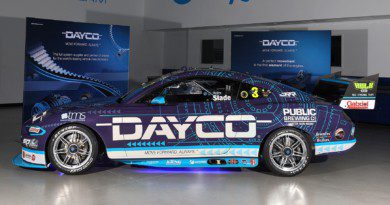BMW M3 and M4 to arrive early 2021
The all-new BMW M3 and M4 will arrive in Australia in Q1, 2021.
BMW says the number of powertrain configurations is unusually high and marks a defining characteristic of both new models. The M3 and M4 are both powered by a six-cylinder in-line engine with BMW M TwinPower Turbo in two states of tune, depending on the transmission.
M3 and M4 continue to be offered with a six-speed manual transmission, which is unique in the category. According to BMW, these models deliver 353kW and 550Nm and achieve standard sprint times of 4.2 seconds.
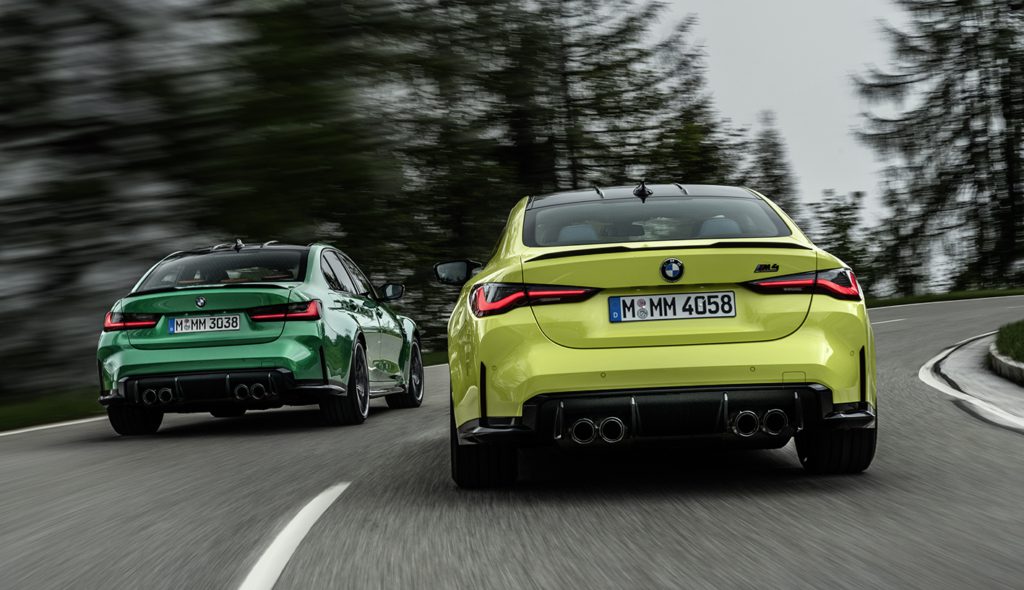
M3 and M4 Competition models take power and torque levels to 375kW and 650Nm and feature an eight-speed M Steptronic transmission with Drivelogic. BMW says the standard sprint time for these models is 3.9 seconds.
All variants will be offered in rear-wheel-drive initially. The M3 and M4 Competition will debut later next year with BMW’s M xDrive system, which marks a first for BMW in this segment.
BMW says the engines powering the new M3 and M4 blend high-revving tendencies with the latest version of M TwinPower Turbo technology, resulting in a new high point for six-cylinder in-line petrol units from BMW in the areas of power and torque. Lightweight design and exceptional rigidity are standout attributes of the performance-maximising components of the base engine.

Two turbochargers with indirect charge air cooling, a flow-optimised air intake system and a petrol direct injection system working with maximum pressure of 350 bar, help generate the engine’s instantaneous power delivery and appetite for revs. The power unit serves up peak torque of 550Nm, from 2,650 to 6,130rpm while maximum power output of 353kW is available at 6,250rpm.
The engine fitted to the Competition models maintains peak torque across a wide rev band, with 650Nm on tap between 2,750 and 5,500rpm. Maximum output of 375kW is developed at 6,250rpm, with the engine’s redline arriving at 7,200rpm.
According to BMW, M3 Sedan and BMW M4 Coupé take 4.1 seconds to power from 0 to 100 km/h while 0 to 200km/h takes 13.7 seconds. The Competition models each accelerate from 0 to 100 km/h in 3.9 seconds and from 0 to 200km/h in 12.5 seconds.
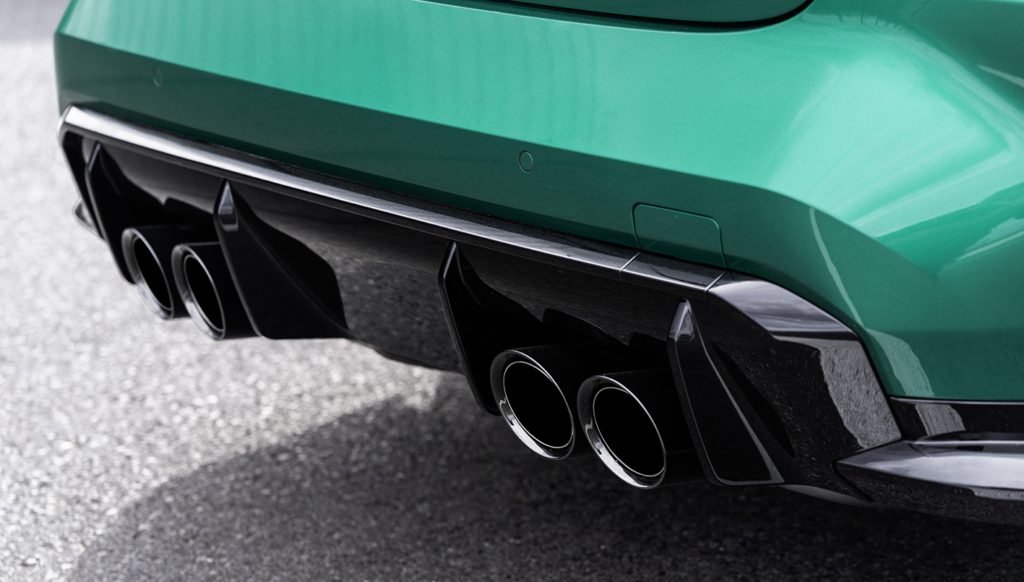
A model-specific exhaust system with electrically controlled flaps provides an emotionally rich soundtrack while a bespoke cooling system ensures optimal operating temperatures are maintained at all times for all powertrain components.
A central cooling module is joined by two remote high-temperature radiators in the wheel arches. In the Competition models the system also includes an additional engine oil cooler and separate transmission oil cooler.
The engine’s oil sump has two separate chambers and an integrated suction channel. An additional suction stage allows the map-controlled oil pump to draw lubricant from the smaller chamber, which steps in when extra capacity is needed. This ensures a reliable supply of oil at all times, even under extreme lateral and longitudinal acceleration.

The manual gearbox features Gear Shift Assistant, which uses engagement speed control to ensure slip-free operation when downshifting under braking into corners.
BMW says the eight-speed M Steptronic transmission with Drivelogic in the Competition models is distinguished by ratio spacing perfectly attuned to the engine’s characteristics and a broad overall ratio spread. This enables fully automatic gear changes and manual shifts with the M-specific selector lever or shift paddles on the steering wheel. The transmission’s shift characteristics are adjusted using the Drivelogic button integrated into the selector lever. The driver can access three clearly distinct setups in both automatic and manual mode.
The engine fitted to the Competition models maintains peak torque across a wide rev band, with 650Nm on tap between 2,750 and 5,500rpm.
For the first time in the history of the M3 and M4, customers can specify an all-wheel-drive system as an alternative to traditional rear-wheel-drive.
The M xDrive system has a rear-wheel bias and links up with the Active M Differential at the rear axle. The driver can access the Setup menu to choose between 4WD and 4WD Sport modes, the latter directing a greater proportion of the engine’s torque to the rear wheels.

Switching off DSC (Dynamic Stability Control) brings 2WD mode into the equation. Sending power to the rear wheels only, and suspending stabilising interventions from the control systems, treats experienced drivers to an uncorrupted, no holds barred driving experience. BMW will offer the M xDrive system on the M3 and M4 Competition by late 2021.
A model-specific package of bracing elements for the engine compartment, a front axle subframe with aluminium shear panel, underfloor bracing elements and a rear axle subframe with a rigid connection to the body, all play a part in the cars’ precise handling, even in dynamically intense situations.
Adaptive M suspension with electronically-controlled shock absorbers, M-specific kinematics and elastokinematics for the front and rear axles are standard features. The cars also have M Servotronic steering with a variable ratio and an M-specific version of the integrated braking system, which presents the driver with two different brake response and pedal feel settings.
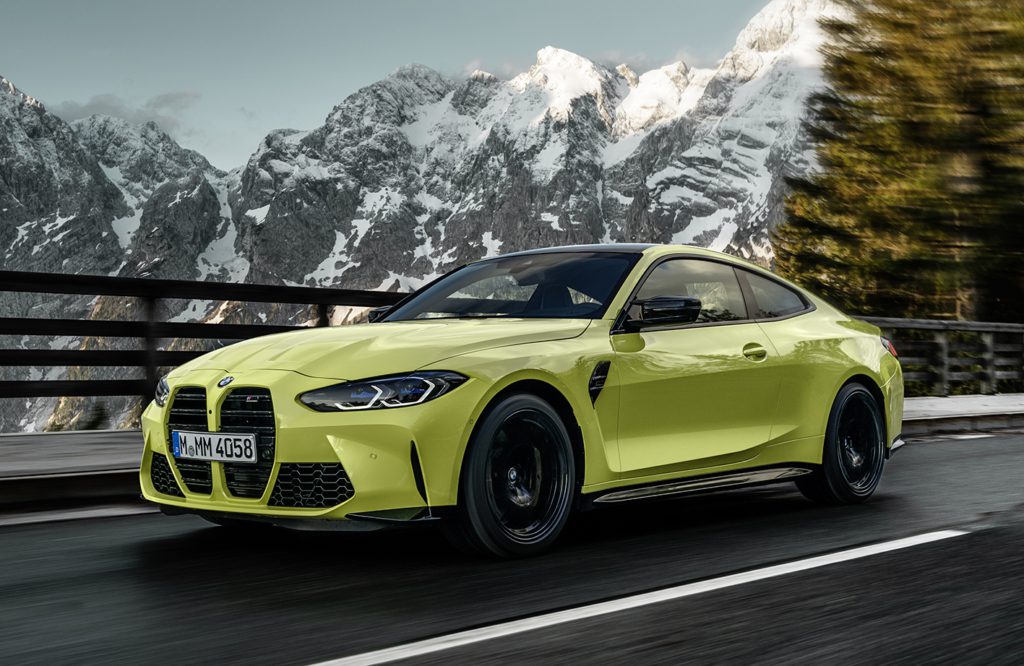
BMW says the introduction of an integrated wheel slip limitation function allows the DSC system to work with increased precision. In addition, the standard inclusion of M Dynamic Mode opens the door to a particularly sporty driving experience, complete with controlled drifting ability.
Standard specification also features forged M light-alloy wheels – in 19-inch format at the front axle and 20-inch at the rear. Tyres are 275/35 ZR19 at the front and 285/30 ZR20 at the rear.
The distinctive body designs of the new M3 and M4 feature the M-specific version of the large, vertical BMW kidney grille with horizontal bars, powerfully sculpted wheel arches with eye-catching M gills and prominently extended side sills with attachment parts for the front and rear aprons.
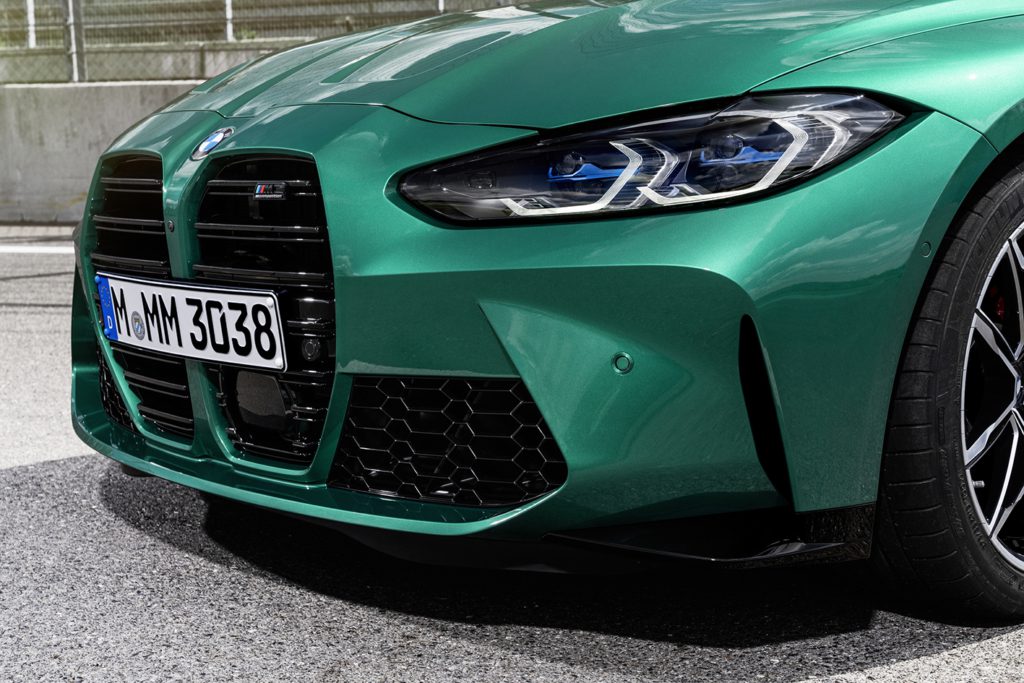
The sedan and coupé also have a roof made from carbon-fibre-reinforced plastic (CFRP) with aerodynamically optimised fins, a rear spoiler and the two pairs of large exhaust tailpipes that are now a customary feature of M cars.
BMW Laserlight is fitted as standard equipment, allowing a high-beam range of more than 500 metres.
The selection of exterior paint finishes includes the new and exclusive shades Sao Paulo Yellow non-metallic, Toronto Red metallic and Isle of Man Green metallic. An optional M Carbon exterior package and model-specific BMW M Performance Parts can also be ordered.

Among the interior design highlights are clearly structured surfaces and a cockpit design that ensure the driver’s focus remains on the driving experience.
Newly developed, electrically adjustable M sport seats and fine-grain Merino leather trim with extended features are standard, with seat ventilation also available for the first time.
A standout highlight of the options list is the new M Carbon bucket seats with a structure-based design, which combine racing functionality with a lightweight construction and sumptuous workmanship.

These innovative seats have integral head restraints which can be dismantled for track driving, an illuminated model badge and electric adjustment. The race car-inspired structure also enables the use of multi-point racing seat belts.
The control and display system comprises an array of new features which play their role in the cars’ engaging driving experience.
M Drive Professional, which makes its debut on the new models, has been conceived specifically for track driving. It includes the innovative new M Traction Control, which allows the new integrated wheel slip limitation function of the DSC system to be adjusted (through 10 stages) to the driver’s personal preferences and needs.
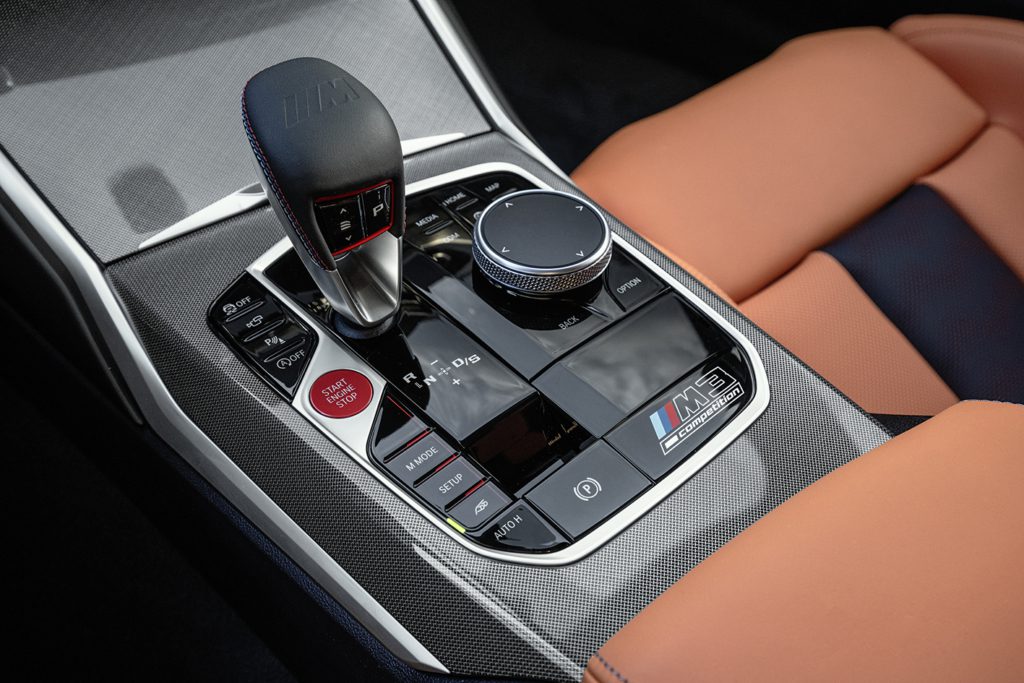
Other elements of M Drive Professional are the M Drift Analyser, which records and rates driving stats posted in dynamic cornering manoeuvres, and the M Laptimer, which supplies lap times and other information generated during track sessions.
The Setup button on the centre console provides direct access to the settings options for the engine, chassis, steering and braking system, plus – depending on the model and specification – the M xDrive system, Gear Shift Assistant, and traction control. Two individually composed configurations for the overall vehicle setup can then be stored and called up again instantaneously at any time using the M buttons on the steering wheel.
The control panel on the centre console also houses the M Mode button as standard. This can be used to adjust the responses and characteristics of the driver assistance systems and the displays in the instrument cluster and Head-Up Display to deliver a driving experience suited to the situation at hand. The driver can choose from Road, Sport, and Track mode.

BMW says cutting-edge driver assistance systems ease the driver’s workload in monotonous or unclear situations on the road. Both competition models come standard with Driving Assistant Professional, including Steering and Lane Control Assistant, Active Cruise Control, Cross Traffic Warning for front and rear, Lane Departure Warning and Lane Change Warning.
Parking Assistant Plus with Parking Assistance, Surround View and Reversing Assistant; the BMW Head-Up Display with M-specific content; and the Speed Limit Info road sign detection system are also standard.
Further standard equipment includes Comfort Access System for keyless entry, three-zone automatic climate control, LED interior lighting including ambient lighting, and a 16-speaker Harman Kardon surround sound system to enhance comfort in everyday driving and over longer journeys.

BMW Live Cockpit Professional – with its fully digital display grouping, cloud-based navigation system BMW Maps and the BMW Intelligent Personal Assistant – is also fitted as standard on the new BMW M3 Sedan and new BMW M4 Coupé.
Additionally, updated wireless smartphone integration enables the use of Apple CarPlay and Android Auto via the car’s operating system.
A steel roof with integral glass tilt/sliding sunroof is available as a no-cost option for both models as an alternative to the standard carbon-fibre version.
Optional equipment allowing for further individualisation includes the M Carbon exterior package, Active Seat Ventilation for the front seats and Remote Engine Start.

BMW M3 and M4 2021 line-up
| Variant | Engine | Power | Torque | Trans. | 0-100km/h (sec) | MRLP |
| M3 | 3.0-litre six-cylinder petrol TwinPower Turbo | 353kW | 550Nm | Man | 4.2 | $144,900 |
| M4 | 3.0-litre six-cylinder petrol TwinPower Turbo | 353kW | 550Nm | Man | 4.2 | $149,900 |
| M3 Competition | 3.0-litre six-cylinder petrol TwinPower Turbo | 375kW | 650Nm | Auto | 3.9 | $154,900 |
| M4 Competition | 3.0-litre six-cylinder petrol TwinPower Turbo | 375kW | 650Nm | Auto | 3.9 | $159,900 |



